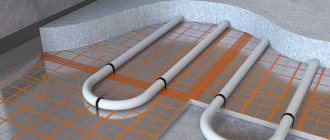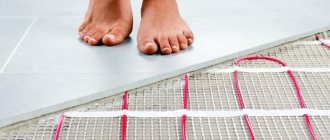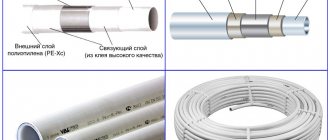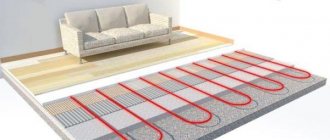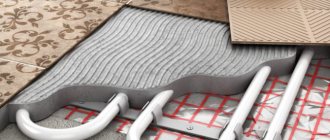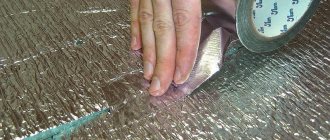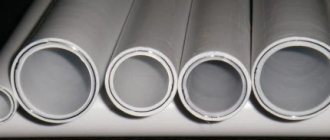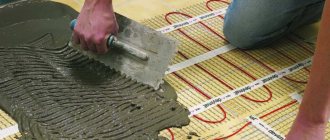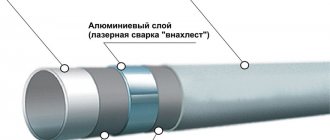Metal-plastic pipes are recognized as the best material for creating a “warm floor” system. Although there are many other materials to choose from in the building materials market. A warm floor made from metal-plastic pipes will be installed “excellently” if high-quality material is used in the work.
The well-known name of the manufacturer always remains a guarantee of quality for the buyer. It is dangerous to purchase metal-plastic pipes of an unknown brand. You can buy a fake. The main factor why metal-plastic pipes are chosen is the combination of quality and affordability.
Metal-plastic composition
Pex-al-pex tube, which consists of 5 layers, is a metal-plastic material. The description of each layer gives an idea of the strength and reliability of the material:
- The PE layer inside is responsible for the technical parameters of the structure (pressure, temperature). Consists of polyethylene (PE) that has undergone an extrusion process and has been cross-linked. The smooth surface of the first layer does not allow debris particles to accumulate on the walls.
- The adhesive composition is necessary for a reliable connection of polyethylene and aluminum foil.
- Aluminum with gas-tight properties consists of foil. Its peculiarity is that it is rolled up along its entire length. It has great heat transfer, the floor warms up quickly. It is thanks to him that the structure takes the given shape and holds it.
- The second adhesive composition.
- Polyethylene on the outside protects against mechanical damage and corrosion. For water-type floor heating, cross-linked, high-density polyethylene is used in the fifth layer.
The quality, or more precisely, the strength of the pipe, decreases if the manufacturer uses cheap glue of questionable quality. If MP costs less, then its strength is significantly lower. The material will last a short time.
It is easy to check the strength of metal-plastic. A piece of it is heated over tongues of fire up to 100 degrees. If it does not delaminate under the influence of high temperature, then it contains a good adhesive composition. It is worth choosing the chosen manufacturer.
Advantages
- The expansion coefficient characterizes the moderate ability of a material to increase in size.
- Metal-plastic pipes for a warm water floor are filled with concrete solution. The strength of the material is important. Flexibility is needed as they bend. It is the aluminum layer that provides these properties.
- It is possible to use a solid pipe by bending it into a snake. There are no joints and the shape of the material is not lost. The absence of joining of pieces when installing floors will allow you to avoid pre-programmed accident sites.
- The maximum permissible exposure temperature is + 95°C. In the operating state of the “warm floor” system, the temperature reaches a maximum of +36 ° C.
- The permissible operating pressure is 10 bar. In a residential system it ranges from 1.5 bar to 5.0 bar.
- It is easy to connect the pipe to other links in the heated floor chain. For this, adapters, fittings, and couplings are used. They can be bought at any hardware store. Selected according to pipe diameter.
- Manufacturers guarantee a 50-year service life.
- The material resists corrosion.
- The system is mounted from environmentally friendly material that does not react with particles from water.
- The heated floor works silently, good sound insulation.
Types of water heated flooring
Today, two types of system creation technologies have gained popularity:
- Concrete.
- Flooring.
The concrete option consists of placing heating components under the screed. This technology is characterized by the presence of a significant amount of labor-intensive work, which also requires spending a lot of time and resources. Only after the monolithic screed has completely dried, the finishing floor covering is laid. Moreover, the maximum drying time for concrete to reach brand strength can be twenty-eight days. The interesting thing is that despite the complexity of implementation, this technology is very popular.
Laying technology is much simpler. For its implementation, ready-made building materials are used, the use of which greatly speeds up the installation procedure of the heating system. However, this solution to the problem is more expensive. Laying several layers of flooring is quite an expensive undertaking. The flooring method, in turn, is divided into three types of system: wooden (modular and slatted), as well as polystyrene.
Manufacturer's choice
High quality material is available on the construction market. The leaders in its production are the following companies:
- Valtec and Ape, products from Italy;
- Uponor and Rehau, a German product;
- Hydrosta, South Korea.
In order not to be disappointed in the work done, it is not recommended to buy metal-plastic pipes for heated floors at a low price from an unknown manufacturer. Otherwise, you can buy poor quality pipes.
How to install a collector group?
Whatever method of installing the heated floor you choose, in any case you will have to connect a cabinet for the collectors. After this installation, you need to connect the return and supply pipes to it. The second of them carries hot coolant, heated by the boiler. And already cooled water passes through the first pipe. It goes back to the heating unit, where it is again brought to the desired temperature. This ensures continuous circulation of water, provided by a special pump connected to the system.
It is best to mount the collector box in the center of the room. Moreover, this must be done as close as possible to the floor surface. This will make the system more efficient and economical.
Shut-off valves must be installed on both pipes. It will allow pipelines to be disconnected for repair work, if necessary. Metal-plastic pipe products and the valve are connected using a fitting. Then the collector is connected. An air vent is mounted on one side. A drain valve is installed on the second.
Watch the video:
Selection of pipe diameter
The installation of metal-plastic into the “warm floor” system is carried out strictly in compliance with the installation rules. The pipes themselves hold their shape well when turning. The main thing is to ensure that the bends are performed correctly.
The diameter of the pipe affects the ease of working with the MP pipeline of the “warm floors” system. The 16 mm section is considered the most convenient. It is recommended for a novice master to start working with it. Such material carries a minimal amount of water or coolant. For example, in 1 meter of pipe with a cross-section of 16 mm, 110 milliliters of water comes in; with a cross section of 20 mm - 180 milliliters of liquid. It is more difficult to bend the “twenty” into a snake. When laying, a step of 0.5 m is observed. In addition, the 16 mm section is cheaper in price.
Rack mounting technology for wooden bases
This type of installation is relevant for installing the system on the second floor of wooden buildings. This is due to the use of a thin layer of thermal insulation materials.
In general, the installation diagram looks like this:
- First you need to lay the thermal insulation with joists (floor beams). For this purpose, polystyrene or mineral wool is used.
- The thickness of the slats used for installation must be at least twenty-eight millimeters. In this case, the grooves must be made with a width of approximately twenty millimeters.
- Aluminum plates are installed in the finished grooves. Next, a pipeline is installed in them.
- At the last stage, gypsum fiber sheets and the final floor covering are laid.
Selection of pipe connection elements
The connecting element for metal-plastic is a fitting. Compression and press type is used.
- The design of the compression fitting is simple. It consists of a fitting, a cape nut, and a split ring. The connection is made with a wrench; no special tools are required. Such a connection can be re-disassembled and reassembled. But it is not recommended to use it for a small area, as it takes a lot of time.
- The press fitting is quick to install, but requires a special tool.
Minuses
We must try to do everything so that not a single joint goes under the cement screed!
The O-rings in the connecting elements are not at all as reliable as the pipe itself.
They need to be periodically tightened, and after a few years they may need to be replaced. If this is not done, water will begin to ooze out. In addition, scale may settle at the joints.
Pipes must be protected from freezing.
After many heating-cooling cycles, separation of the components of the material can occur.
Sometimes the disadvantage is called thermal conductivity, which is lower than that of metal. But if you take into account how much more difficult and expensive it is to install metal tubes, their vulnerability to corrosion, weight and tendency to become overgrown with scale, then this disadvantage is covered a hundredfold.
If we compare metal-plastic heating with other plastic options, then only reinforced polypropylene can compete with it. Metal-plastic is also very suitable for a warm floor system!
Selecting a laying pattern and amount of material
Installation of the system begins with calculating the length of the metal-plastic pipeline. The coils are laid with a step between them of 30 to 35 cm. A coil with a hundred meters of material is consumed for 20 m2. The length is calculated based on the area covered.
One loop must be made from a continuous pipeline. It is not recommended to consider the area under furniture and large household appliances. Thus, overheating in these places can be avoided and the financial expenditure on purchasing extra centimeters of pipe is reduced.
Laying is carried out according to two schemes: snake and spiral.
For a small area, it is recommended to choose a snake. It appears simpler as a pipe. But its disadvantage is the uneven heating of the floor. The temperature drops towards the exit. In a small area this is not visible. A spiral is laid out over a large area. The floor is heated evenly. But there are many bending places, making it more difficult to install.
Pipes are sold in coils: 100 m, 200 m, 500 m. Calculations will tell you which one to choose.
Preparatory work is being carried out: insulation is laid, then film, reinforcing mesh. The pipeline is attached to the mesh with clamps. At least 10 cm is retreated from the wall and only then the first turn is laid.
It is recommended that three people perform the installation: the first person unwinds the coil evenly, the second, starting from the intended pattern, makes bends and lays the material on the floor, the third fixes the position of the pipe with clamps or staples on the concrete floor.
The bends are fixed first, then the middle of the coil length. Once installation is complete, you can add fasteners. A distance of 0.5 m to 1.0 m is maintained between them. These actions will help to avoid raising the metal-plastic when it is poured with concrete. Having completed its installation, it is connected to the collector.
Modular installation technology for wooden subfloors
To implement this installation method you need to do the following:
- Lay a thermal insulation layer.
- Next, ready-made modules made from chipboard are installed. In these plates, the channels for the pipeline and the corresponding grooves necessary for the aluminum plates must be pre-cut.
- Aluminum plates and pipe products are mounted with loops that snap into the above channels.
- The top layer of gypsum fiber sheets and the final floor covering are being laid.
Styling tools
- In order for the metal-plastic pipe for a heated floor to bend correctly, a special tool is used - a pipe bender. With its help, the pipe takes the desired shape and configuration quickly and without the application of human force. This tool is usually only available to a specialist. At home, you can bend a coil using a simple conductor device. It is dangerous to perform turns manually. There is a possibility of bending.
- Use a cutter to cut the material exactly to the required length. Visually resembles ticks. It is replaced with a construction knife. A hacksaw will leave burrs on the cut.
- To ensure the tightness of the joints of pipes with fittings, by adjusting them after cutting, a calibrator is used.
- Pipe wrenches.
- Sandpaper.
- To connect a press-type fitting, press pliers are used.
Material price policy
The popularity of metal-plastic is explained by its price. It is considered an inexpensive material for installing a heating system. Its price varies depending on the pipe cross-section and the choice of manufacturer.
The average price tag for metal-plastic per linear meter: from 35 to 90 rubles.
Installation of one linear meter, performed by a specialist from the construction team, costs 120-500 rubles (stripping of material, connecting corners and fittings).
The cost of fittings varies depending on the material from which they are made and their configuration. A compression fitting costs the buyer from 130 to 380 rubles. The more complex the angles, adapters, tees, the higher the price: from 500 to 700 rubles per unit. Press fittings can be bought from 100 to 250 rubles.
Flaws
Two layers of screed will significantly raise the floor level
. Like all other systems, water floors have disadvantages:
- complexity of installation;
- installation of a water pump is required to increase water pressure in horizontal pipes;
- reducing the height of the room due to several layers required for the installation of such a system;
- are not suitable for use in apartments, since such a system reduces the water pressure in the risers. For more information about the advantages and disadvantages of this design, watch this video:
Most often, a water floor is used for heating private houses, in which case it is fully justified in terms of durability and economic benefits.
It is best to involve specialists who will perform all the work, strictly adhering to installation technology. They will help you correctly calculate the consumption of materials and pipe laying pitch.
